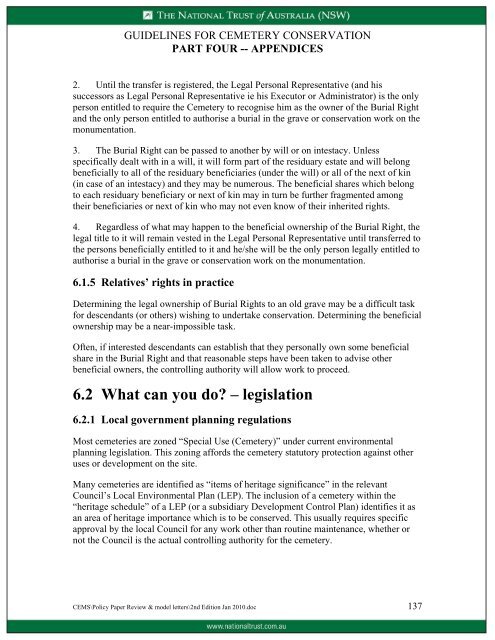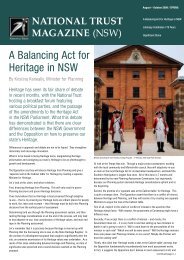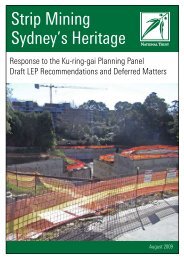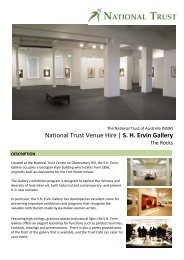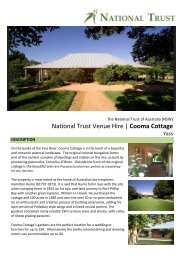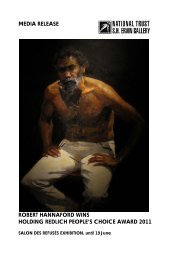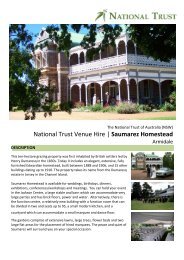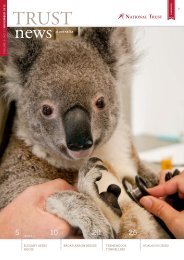Guidelines for Cemetery Conservation - National Trust of Australia
Guidelines for Cemetery Conservation - National Trust of Australia
Guidelines for Cemetery Conservation - National Trust of Australia
You also want an ePaper? Increase the reach of your titles
YUMPU automatically turns print PDFs into web optimized ePapers that Google loves.
GUIDELINES FOR CEMETERY CONSERVATION<br />
PART FOUR -- APPENDICES<br />
2. Until the transfer is registered, the Legal Personal Representative (and his<br />
successors as Legal Personal Representative ie his Executor or Administrator) is the only<br />
person entitled to require the <strong>Cemetery</strong> to recognise him as the owner <strong>of</strong> the Burial Right<br />
and the only person entitled to authorise a burial in the grave or conservation work on the<br />
monumentation.<br />
3. The Burial Right can be passed to another by will or on intestacy. Unless<br />
specifically dealt with in a will, it will <strong>for</strong>m part <strong>of</strong> the residuary estate and will belong<br />
beneficially to all <strong>of</strong> the residuary beneficiaries (under the will) or all <strong>of</strong> the next <strong>of</strong> kin<br />
(in case <strong>of</strong> an intestacy) and they may be numerous. The beneficial shares which belong<br />
to each residuary beneficiary or next <strong>of</strong> kin may in turn be further fragmented among<br />
their beneficiaries or next <strong>of</strong> kin who may not even know <strong>of</strong> their inherited rights.<br />
4. Regardless <strong>of</strong> what may happen to the beneficial ownership <strong>of</strong> the Burial Right, the<br />
legal title to it will remain vested in the Legal Personal Representative until transferred to<br />
the persons beneficially entitled to it and he/she will be the only person legally entitled to<br />
authorise a burial in the grave or conservation work on the monumentation.<br />
6.1.5 Relatives’ rights in practice<br />
Determining the legal ownership <strong>of</strong> Burial Rights to an old grave may be a difficult task<br />
<strong>for</strong> descendants (or others) wishing to undertake conservation. Determining the beneficial<br />
ownership may be a near-impossible task.<br />
Often, if interested descendants can establish that they personally own some beneficial<br />
share in the Burial Right and that reasonable steps have been taken to advise other<br />
beneficial owners, the controlling authority will allow work to proceed.<br />
6.2 What can you do? – legislation<br />
6.2.1 Local government planning regulations<br />
Most cemeteries are zoned “Special Use (<strong>Cemetery</strong>)” under current environmental<br />
planning legislation. This zoning af<strong>for</strong>ds the cemetery statutory protection against other<br />
uses or development on the site.<br />
Many cemeteries are identified as “items <strong>of</strong> heritage significance” in the relevant<br />
Council’s Local Environmental Plan (LEP). The inclusion <strong>of</strong> a cemetery within the<br />
“heritage schedule” <strong>of</strong> a LEP (or a subsidiary Development Control Plan) identifies it as<br />
an area <strong>of</strong> heritage importance which is to be conserved. This usually requires specific<br />
approval by the local Council <strong>for</strong> any work other than routine maintenance, whether or<br />
not the Council is the actual controlling authority <strong>for</strong> the cemetery.<br />
CEMS\Policy Paper Review & model letters\2nd Edition Jan 2010.doc 137


